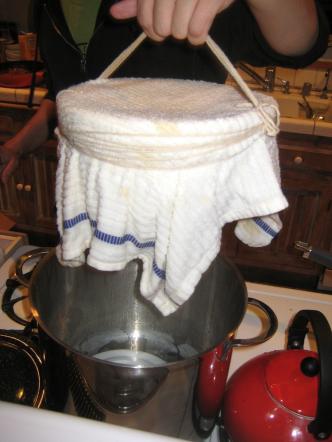This is Part Three of a mega-epic undertaking to make a real Christmas pudding. Also check out Part One, in which the pud gets cooking and Part Two, in which the pud cures.
After hours of stirring and steaming (Part I), and weeks of soaking in alcohol (Part II), this week saw the third and final act of our holiday saga: the eating of the Christmas Pud. Not content with just one epic ordeal of a recipe on the table, we preceded the pudding with a meal of homemade pork tamales, a culinary challenge that may warrant its own post in the future, and surely a dish that any Victorian gentleman worth his sideburns would recognize as a Christmas classic. Hrmmnyes, indubitably. I’m sorry, did I say Christmas classic? That’s a typo; I meant “monocle-droppingly grave breach of decorum.” But hey, this is America, right? Bah humbug, bring us tamales and pudding!
D-Day for a Christmas Pudding is not just a simple matter of passing out servings. Before knife touches pud there are still three major steps left in this marathon: making sauce, reheating, and serving properly. The process pays off in pyrotechnics and (spoiler alert) a logic-defyingly delicious dessert.
In case you were worried that this booze-intensive recipe, followed by weeks of liberal sprinklings of brandy, would meet with a sober, alcohol-free end, FEAR NOT! No Christmas pud is complete without its traditional topping, a combination of butter, sugar, and brandy called Hard Sauce.
The first thing to know about Hard Sauce is that you need to make it a few hours before you serve your pudding, because it needs to re-harden in the fridge until it returns to the consistency of butter. Yes, this alleged “sauce” is yet more proof that Brits and Americans do not speak the same language; it’s solid, spreadable, and has about as much in common with a conventional sauce as Christmas Pud has with a Jello pudding cup.
Hard Sauce for a Christmas Pudding:
(Recipe from Saveur, makes 1 ½ cups “sauce”)
Ingredients:
12 Tbsp unsalted butter, at room temperature
3/4 cup sugar
4 Tbsp brandy or rum
Instructions:
1. Beat the butter and sugar together until light and fluffy – this is possible to do by hand, but an electric mixer would save a lot of time. Either powdered sugar or granulated sugar can be used; powdered results in a smoother texture.
2. Add brandy, beat until everything is combined, and refrigerate until pudding time. The hard sauce winds up looking a bit like frosting. Serve it in a dish and let people add a scoop alongside their slice of pudding.
 Reheating the PudReheating the Pudding:
Reheating the PudReheating the Pudding:
Time: 2 hours
It might be tempting to rip the covers off your pudding when you finally remove it from its cool, dark resting place, but in order to making the reheating process easier you’ll want to keep those layers of paper, foil, and towel cinched around the rim of your pudding’s bowl. Once again you’ll have to attach a twine handle and repeat the cooking process described many moons ago in Part I, lowering the pudding onto a platform at the bottom of a pot above 2 inches of simmering water. Thankfully it only needs to steam for two hours this time, not the original eight. (Again: EIGHT!?)
Serving the Pudding:
1. After steaming the pudding, take its cover off and set it aside to cool slightly. That’s right, even after two more hours of steaming you still have to wait, but a little cooling will make the pudding less likely to break up before you serve.
 2. Put your serving plate
upside down on top of the bowl and pudding, then flip to upend your dessert
onto a serving plate. It comes out as a mottled, glistening, dark brown dome
shape, almost black, in fact. And it gets even darker after you light it on
fire.
2. Put your serving plate
upside down on top of the bowl and pudding, then flip to upend your dessert
onto a serving plate. It comes out as a mottled, glistening, dark brown dome
shape, almost black, in fact. And it gets even darker after you light it on
fire.
3. Pour a shot of warm brandy or rum over the pudding. Considering the time that a pud spends soaking in liquor it probably doesn’t need much help to turn into a holiday firebomb, but nevertheless it is tradition to pour a little alcohol on top and set it ablaze before triumphantly carrying it to the table. One would usually do this with brandy, the same brandy you’ve been sprinkling over the pudding for the past few weeks or months, but a few rounds of sazerac cocktails during dinner prep killed off our bottle before dinner time and we had to resort to rum. Whatever your ammunition of choice is, heat the liquor on the stove briefly (booze ignites more easily when it’s warm and evaporating) and pour it over the pud. Strike a match. Hit the lights. Merry Christmas.
So what does it taste like, this ball of raisins and peels and currants and spices and beer and rum and eggs and flour and, yes, beef fat? Well first thing’s first: it doesn’t taste like meat. Years ago I remember my Dad making an apple pie with pig leaf lard at Thanksgiving, and there was a faint but distinct bacon flavor. No such problems with Christmas Pudding. And to dispel another holiday-dessert-related fear, the pud is nothing like a fruitcake. In fact it is incredibly moist, with no trace of any bready, cake-like texture.
 The most recognizeable
flavor on the first bite was the char from the freshly-extinguished booze fire.
That’s not to say the burnt flavor was overpowering, it was just the only one I
could recognize; over the past five weeks of curing all twenty-or-so of the
ingredients had blended together completely, and while the pudding was still
very strongly flavored, it was with a new and unfamiliar taste. Textures varied
from bite to bite, but while I might be able to guess that a crunchier spoonful
probably had an almond in it and the squishier one that preceded it didn’t, both
had exactly the same flavor – sweet, rich, with maybe a little bit of the tart
sharpness of raisins, currants, and citrus peel, and an aroma like the spices
in a hot cider or mulled wine. It was very good.
The most recognizeable
flavor on the first bite was the char from the freshly-extinguished booze fire.
That’s not to say the burnt flavor was overpowering, it was just the only one I
could recognize; over the past five weeks of curing all twenty-or-so of the
ingredients had blended together completely, and while the pudding was still
very strongly flavored, it was with a new and unfamiliar taste. Textures varied
from bite to bite, but while I might be able to guess that a crunchier spoonful
probably had an almond in it and the squishier one that preceded it didn’t, both
had exactly the same flavor – sweet, rich, with maybe a little bit of the tart
sharpness of raisins, currants, and citrus peel, and an aroma like the spices
in a hot cider or mulled wine. It was very good.
It was so good, in fact, that I wish I could have reached for seconds. I think we all would have, if we’d been physically able…Which brings me to my last observation about Christmas Pudding: MAN is it heavy. The stirring, the curing and the laundry list of ingredients crammed inside give this pud the density of a black hole. And that’s before the Hard Sauce. I think the five of us made it through a third of one pudding, and remember, we made two.
So the saga of Christmas Pudding ends with a half-eaten dessert headed back to the cupboard from which it came. Hey, it spent five weeks there already, at least we know the leftovers will keep. I can honestly say that this is the longest recipe I’ve ever attempted, and I certainly wouldn’t set out to do it without three or four other pairs of hands to help with the work. But in the end I think it was worth both the work and the wait; the pudding wasn’t just good, it was also exactly as strange and unique a dessert as you would hope to get from such a bizarre recipe. I can see why people in England look forward to this ritual every year. I’m not making any guarantees about next Chrismas, mind you. But I think at least now I understand.
Happy Holidays.

Jonathan Bensick hails originally from Oakland, California, has also lived in St. Louis, MO and Florence, Italy, and now resides in a two-bit Southern California burg named El Pueblo de Nuestra Senora de la Reina de Los Angeles del Rio de Porcuincula where, at the risk of jinxing himself, he is 38% of the way to being a licensed Architect. His latest non-pudding post for us was A Passage to Indian Food, or an Indian-ventory of Spices.




